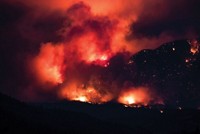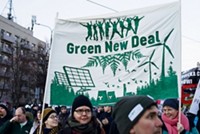Advertisement
Grab your lab coat. Let's get started
Welcome!
Welcome!
Create an account below to get 6 C&EN articles per month, receive newsletters and more - all free.
It seems this is your first time logging in online. Please enter the following information to continue.
As an ACS member you automatically get access to this site. All we need is few more details to create your reading experience.
Not you? Sign in with a different account.
Not you? Sign in with a different account.
ERROR 1
ERROR 1
ERROR 2
ERROR 2
ERROR 2
ERROR 2
ERROR 2
Password and Confirm password must match.
If you have an ACS member number, please enter it here so we can link this account to your membership. (optional)
ERROR 2
ACS values your privacy. By submitting your information, you are gaining access to C&EN and subscribing to our weekly newsletter. We use the information you provide to make your reading experience better, and we will never sell your data to third party members.
Climate Change
UN summit on climate draws world’s gaze
Student-led protests call for government action to prevent catastrophic changes
by Cheryl Hogue
September 13, 2019
| A version of this story appeared in
Volume 97, Issue 36

Students around the world plan to leave classrooms on Sept. 20 and take to the streets, protesting the lack of government action to restrain human-caused climate change. Adults, including some academics, will walk off the job and join them in calling for an end to fossil fuel use. This global climate strike grew from the actions of Greta Thunberg, a 16-year-old climate activist from Sweden who helped stoke a global movement of weekly climate demonstrations by students on Fridays. The protesters are fed up with the lack of action at the scale scientists say is needed to stave off catastrophic climate effects by the end of the century.
This week’s global climate strike is aimed at leaders assembling at a Sept. 23 summit convened by United Nations secretary general António Guterres. The UN chief invited Thunberg, who has spoken at climate change negotiations and before parliaments in Europe, to address the gathering at UN headquarters in New York City. Thunberg has said the climate demonstrations will cease and students will return to classrooms as soon as government leaders “start listening to the science and give us a future.”
“She is part of a growing wave of young people who have lost patience with the slow pace of progress from their leaders,” Guterres says. At the summit, Thunberg will be part of a group of about 100 young people from around the globe who are hoping to hold world leaders accountable.
With this in mind, Guterres told the government attendees to bring “concrete, realistic plans” to the summit to boost their efforts beyond the pledges made in the 2015 Paris Agreement for controlling greenhouse gas emissions. In that accord, the world community set a a goal that by the end of the century, the global average temperature will rise less than 2 °C compared with preindustrial levels.
Yet even if every country meets the promises it made under the Paris deal, the world will still experienceat least a 3 °C global average temperature rise by 2100. “Even more worrying is that many countries are not even keeping pace with their promises under the Paris Agreement,” Guterres says.
Driving the protests and Guterres’s call for the summit is a scientific report issued last October by the Intergovernmental Panel on Climate Change (IPCC). It warns that the world is on a path to catastrophic effects from rapid global warming. To prevent this, human-generated emissions of carbon dioxide must drop by 45% from 2010 levels by 2030 and become net zero—meaning any emissions are offset by removal from the atmosphere—by 2050, the IPCC says.
The UN chief is keeping the IPCC’s time horizon front and center, asking governments to come to the summit with action plans. Guterres is also calling for nations to shift taxes from wages to releases of carbon dioxide. “We should tax pollution, not people,” he said in June. He’s urging countries to end fossil fuel subsidies. He also wants the world to stop constructing coal-fired power plants as of next year.
Guterres is in for a tough sell.
Global political winds have shifted since the Paris deal was clinched in 2015, and observers say some countries are less motivated to take on climate change plans than they were 4 years ago. In addition, the European Union and the US, which dominated climate change talks in the last quarter century, will likely play subdued roles at the summit, though for different reasons.
The term of the current European Commission, the executive branch of the EU, is winding down, with new leaders to take office Nov. 1. This means the lame-duck current commission will represent the political bloc at the summit. Later this year, the new leaders are expected to formally introduce a new EU plan to combat climate change, says Wendel Trio, director of the European branch of Climate Action Network (CAN), a global coalition of environmental and other activist groups.
The shift in leadership doesn’t mean the EU will back off on climate change actions, just that it might not be prominent at the summit. Commission president-elect Ursula von der Leyen, who was Germany’s defense minister, has pledged to make climate change and environmental protection top priorities during her tenure, Trio says. Von der Leyen wants the EU to strengthen its commitments to curb greenhouse gases and lead international climate negotiations. She has said she plans to unveil a “green deal” for Europe shortly after she takes office.
In the US, meanwhile, the White House has given no indication whether President Donald J. Trump will attend the summit. Trump in 2017 announced he would withdraw the US from the Paris Agreement as soon as possible, which is at the end of 2020. The US has continued to participate in global climate talks since then, though arguably more quietly than it has historically.
Last month, Trump, a supporter of the fossil fuel industries, skipped the climate change discussion among the heads of Group of Seven major economies at their summit in France. And at the Group of 20 meeting in Japan in June, he pressured other leaders to downplay the fight against climate change. In the communiqué from that meeting, 19 of the countries—all except the US—reaffirmed their commitment to fully implementing the Paris Agreement.
The State Department has confirmed to the UN that the US will participate in the climate summit, according to Luis Alfonso de Alba, the secretary general’s special envoy for the summit. However, US officials have not indicated who will represent the country at the event.
As for China, in June the country reaffirmed its commitment to international cooperation on climate change in a joint statement with France and the UN’s Guterres. But it has made no announcement yet about furthering its emission control plans. A recent report from the World Resources Institute finds China could significantly reduce its greenhouse gas footprint by curbing releases of hydrofluorocarbon refrigerants, methane from coal mines, and nitrous oxide from the production of nitric and adipic acids.
Elsewhere in Asia, some countries plan to rely heavily on coal in the future, says Nithi Nesadurai, president of Environmental Protection Society Malaysia. “New coal projects must be halted, and financial flows have to be shifted away from coal into renewable energy and low carbon development,” says Nesadurai, who is also regional coordinator for CAN Southeast Asia.
Guterres’s timing for the summit is deliberate, explains David Waskow, director of the World Resources Institute’s International Climate Initiative. Next year, countries are expected to make more ambitious emission control pledges under the Paris Agreement. The plans that leaders bring to the Sept. 23 summit may not be detailed, but politically, they will help propel climate negotiations to the next stage in 2020, he says.
While they continue, pressure will continue from young people, including Thunberg, taking to the streets every Friday, demanding action for their future.
“It is they who will inherit our legacy,” Guterres says.







Join the conversation
Contact the reporter
Submit a Letter to the Editor for publication
Engage with us on Twitter